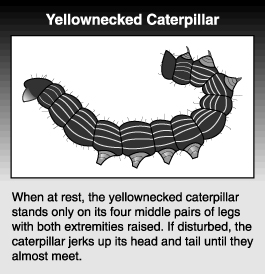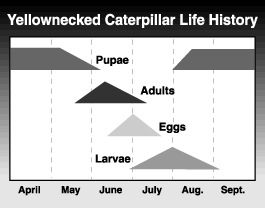by Jay F. Brunner, originally published 1993
Datana ministra Drury (Lepidoptera: Notodontidae)
This insect is found throughout the United States and Canada on a wide variety of host plants. It is uncommon in most orchards of the western United States but is found periodically in large numbers. The reason for its normal scarcity and sudden appearance is poorly understood. It can cause severe damage when present in large numbers but is easily controlled.
Hosts
Besides apple, pear, cherry and most other fruit trees, the yellownecked caterpillar also uses numerous shade and forest trees as hosts.
Life stages
 Egg
Egg
The egg is small and round. It is light colored when first laid but turns darker. Eggs are laid in clusters of up to 100 on the undersides of leaves.
Larva
The young larva is chestnut brown with obscure darker stripes. The fully grown larva is almost 2 inches (50 mm) long and has a bright yellow or orange band just behind the head. The body is distinctly striped black and yellow and is sparsely covered with long, whitish hairs. When disturbed, the caterpillar raises up both ends of its body, clinging to the plant with only its abdominal prolegs.
Pupa
The pupa is brown and about 1 inch (25 mm) long. It is found in the soil.
Adult
The yellownecked caterpillar moth is a cinnamon brown color with 3 or 4 dark lines crossing each wing. The thorax is a reddish brown, and the hind wings are a pale straw color.
Life history
 The yellownecked caterpillar spends the winter in the ground as a pupa.
The yellownecked caterpillar spends the winter in the ground as a pupa.
Adults appear in June and July and fly to host trees where they deposit egg masses. Eggs hatch in 10 to 14 days and the young larvae remain on the same leaf, all feeding with their heads pointing towards the edge of the leaf. They skeletonize the underside of the leaf until they molt to the next instar, at which time they move to other leaves and begin consuming the entire leaf, eating from the edge inward. They tend to remain together as a colony but do not produce a web, as does the tent caterpillar or fall webworm. The larvae mature in about three weeks. They then burrow 2 or 3 inches into the ground and pupate. The caterpillar has only one generation per year.
Damage
Larvae of the yellownecked caterpillar can consume large quantities of foliage. They strip the leaf, leaving only the mid-vein, and may strip several branches on a tree before maturing. This is not often a problem on larger trees, but a young tree can be defoliated.
Monitoring
The first sign that the yellownecked caterpillar may be in the orchard is usually feeding damage. While few such sites are found in commercial fruit orchards, they may be common in nurseries or in orchards where few insecticides are used. Examine foliage in late July or early August.
Management
Insecticides used to control other fruit pests will usually keep the yellownecked caterpillar under control. If infestations are detected early, before larvae have grown and spread, colonies can be cut out of the tree, removed from the orchard and destroyed.
